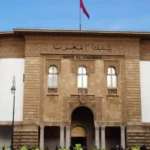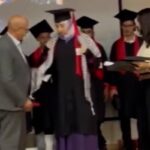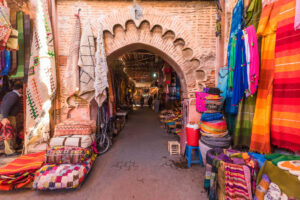Once a hidden gem for local Moroccans seeking a peaceful getaway from the hustle and bustle of Marrakech and Casablanca, the “Blue City” of Chefchaouen is becoming an increasingly popular tourist destination for European and Western travelers.
Instagram has brought Chefchaouen into the spotlight largely thanks to its photogenic features, but this mountain city has so much more to offer beyond its charming exterior and social media appeal.
The rich history of Chefchaouen carries with it a strong and vibrant culture, and the city’s population is rich with local skilled artisans, rug weavers, jewelers, designers, potters, chefs,and bakers who possess knowledge andtraditions that have been passed down for generations.
Though there seems to be no unified consensus among Chefchaouen locals as to why and how the city gained its blue color: some say it is due to the influx of Jewish immigrants fleeing the Spanish Inquisition in 1492, bringing with them the custom of painting their buildings blue. This is a Jewish tradition that has long been used to remind those who practice Judaism of the sky, heaven, and God.
Nestled next to the Rif Mountains, Chefchaouen is in the traditional home territory of the Rifians (or Rif Amazigh), who are the indigenous peoples of this region in Morocco and have resided here for thousands of years, predating Islamic, Spanish, and French influence.
The traditional practice of hand weaving rugs and blankets continues to this day in the Rif Mountains, and there are many shops in the medina of Chefchaouen that sell these handmade rugs.
An ancient tradition of the Rif Amazigh, each rug is made from camel hair, agave, or wool, often embroidered with intricate and traditional symbols of the Rif Amazigh people, each one of special significance. The ingredients for the rugs are sourced locally and hand made by local women in the region. Profits from the rugs support the artisans directly, many of whom spend multiple days per rug, depending on the intricacies and complexity of each design.
Small business owner Abdelhak Garanti runs La Maison Nomad (House of Nomads), located in the medina of Chefchaouen.
Garanti says that the sale of one rug can support an entire family for a week and strongly believes in the importance of purchasing local products made by Amazigh artisans and supporting local families in the region.
Omar Mrakni, who works at La Maison Nomad with Garanti, grew up in the Western Sahara region and now lives in Chefchaouen. He is knowledgeable about rug designs as well as the ancient customs of his culture and explained the meaning of many traditional symbols present on the rugs that are used across different Amazigh cultures.
Mrakni believes the city’s blue and white colors come from the abundance of freshwater in the region, something that sets it apart from other Moroccan regions, most of which do not have that much potable water. Mrakni also believes Chefchaouen got its blue colors to make the city beautiful.
Machkour Mohamed is a co-owner of Local Berber Artisanal, a consignment rug store located off the main tourist paths of the medina in Chefchaouen.
Operated and run by a group of local merchants native to the region, the shop is lush with handwoven rugs made by Amazigh women from the local region. The rugs are sold on consignment, and the women receive a percentage of every sale for their work.
Ahmed, a self-identified Amazigh of the Rif Mountains, lives in a nearby village outside of Chefchaouen, where he practices Amazigh traditional customs such as agriculture, weaving, and visual art, among others.
Ahmed also spends much of his time in the Medina, supporting and advertising local businesses that support Amazigh people.
A skilled tour guide and traditional rug maker, he took me around the city, highlighting prime locations for photographs while teaching me about Rif Amazigh culture.
Ahmed believes the city is painted blue to help with temperature control inside homes and within the city’s walls. Though I have not verified this, he believes the blue and white helps air stay cool in summer and warm in the winter.
Another key attraction within walking distance of Chefchaouen is a well situated trail just beyond the Medina to a Spanish Mosque that sits atop a hill 2 km above the city, overlooking the valley.
At sunset, locals and tourists will come together to watch the sunset.
Built in the 1920s by the Spanish during their colonial rule of the region, it was never used as a mosque by local people and was boycotted.
Though it never became a place for Islamic prayer among the traditional inhabitants of Chefchaouen, the Spanish Mosque remains a popular place amongst locals and tourists from all cultures to gather and view the beautiful sunsets that adorn the blue rooftops of Chefchaouen at the end of the day.
Restaurant Asaada is a traditional Moroccan restaurant located in the center of the medina of Chefchaouen. It is an essential stop for anyone looking to have an authentic Moroccan culinary experience.
Mohammed Asaada, the restaurant’s owner, and his staff are well-versed in Moroccan traditional cuisine and provide a welcoming atmosphere with unassuming hospitality.
Fresh oranges hang for sale in abundant full baskets in the medina of Chefchaouen. Fresh squeezed orange juice is a refreshing must-have, and it is hard to go far without running into a fresh juice vendor who uses the region’s local fruits.
Another key attraction in the region is a scenic half hour’s drive beyond the blue streets of Chefchaouen that will take you to the trailhead of both God’s Bridge and the Akchour Waterfalls (Cascades d’Akchour).
You can reach the trailhead by catching a taxi at the foot of the hill in Chefchaouen, this costs roughly 100-150 MAD per six person van. The ride offers impressive views of the Rif Mountain range on winding roads.
You will pass villages with local townspeople, Amazigh houses practicing their traditional customs, accompanied by the smoky, sweet aroma of tagines that lingers in the wind.
The trail to “God’s Bridge” takes about an hour to hike and is an ambitious journey, but well worth it.
The trail leads to freshwater pools that provide rest and refreshment after a long hike in the summer heat.
The water is crystal clear and is considered sacred among locals within the region. Hikers are expected to travel courteously and pack their garbage in and out when making the trek to these pools.
The trail offers many places to stop and enjoy a tagine or traditional Moroccan cuisine along the river’s edge.
The second and final destination of our trip in this region were the Akchour Waterfalls located about three quarters of the way back along the trail to God’s Bridge.
The trek to the first of several waterfalls lasted about an hour each way and gave way to more picturesque views of the valley and the Rif Mountains.
The freshwater pools along the Akchour River offer a refreshing place to swim and cool off.
There is so much to explore in the region of Chefchaouen that it is hard to do it in one day, or even a weekend. It is evident why such a friendly and hospitable place with such rich culture is growing as a popular destination and being quickly recognized as Morocco’s hidden gem.
Source : Morocco World News
















